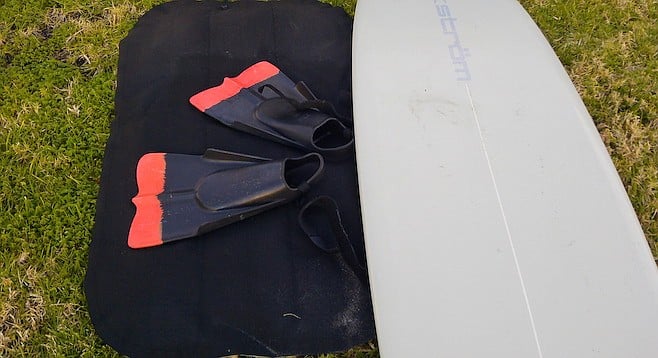 Facebook
Facebook
 X
X
 Instagram
Instagram
 TikTok
TikTok
 Youtube
Youtube

Before the invention of the Morey Boogie Board in the early ‘70s, the surf mat was the vehicle of choice for the novice wave rider. Until that time, liquor stores along the coast rented these rubber tipped canvas devices for 50 cents an hour. They proved great fun until the rock-hard surface sanded chest and arm skin.
By the late ‘70s, surf mats had deflated in response to Boogie fever. That’s when a genius inventor, George Greenough, began to run them full throttle at points like Rincon, in Santa Barbara. Riding in Greenough’s wake was longtime mat surfer Paul Gross.
In 1984 Gross began building mats under the 4th Gear Flyer logo. This handmade, nylon constructed inflatable never caught on in significant numbers, and today remains far less common than its foam and fiberglass cousins.
That rarity has bred a kinship not enjoyed among the mainstream surf community since the pre-Gidget days of the late ‘50s. The global brotherhood of mat riders shares waves, photos, and information, usually via the Internet.
Two of the most notable pockets of mat riders in San Diego exist in Point Loma and Encinitas. Ken McKnight, Peter Saint Pierre, and Henry Hester are among the dominant mat surfers in North County, while Steve Pendarvis is among the top riders in Point Loma. Like most mat riders, this crew tends to be non-territorial and is quick to invite everyone to the party.
While it doesn’t require much time to master, there is a learning curve in mat riding. The challenge with mats is more technical than athletic. Counterintuitive for board surfers, mat riding depends upon fine adjustments for turning, rather than raw power. A mere shift of the head, the lift of one or both fins, a tight squeeze of the fabric— any little thing can alter your ride, for better or worse.


Before the invention of the Morey Boogie Board in the early ‘70s, the surf mat was the vehicle of choice for the novice wave rider. Until that time, liquor stores along the coast rented these rubber tipped canvas devices for 50 cents an hour. They proved great fun until the rock-hard surface sanded chest and arm skin.
By the late ‘70s, surf mats had deflated in response to Boogie fever. That’s when a genius inventor, George Greenough, began to run them full throttle at points like Rincon, in Santa Barbara. Riding in Greenough’s wake was longtime mat surfer Paul Gross.
In 1984 Gross began building mats under the 4th Gear Flyer logo. This handmade, nylon constructed inflatable never caught on in significant numbers, and today remains far less common than its foam and fiberglass cousins.
That rarity has bred a kinship not enjoyed among the mainstream surf community since the pre-Gidget days of the late ‘50s. The global brotherhood of mat riders shares waves, photos, and information, usually via the Internet.
Two of the most notable pockets of mat riders in San Diego exist in Point Loma and Encinitas. Ken McKnight, Peter Saint Pierre, and Henry Hester are among the dominant mat surfers in North County, while Steve Pendarvis is among the top riders in Point Loma. Like most mat riders, this crew tends to be non-territorial and is quick to invite everyone to the party.
While it doesn’t require much time to master, there is a learning curve in mat riding. The challenge with mats is more technical than athletic. Counterintuitive for board surfers, mat riding depends upon fine adjustments for turning, rather than raw power. A mere shift of the head, the lift of one or both fins, a tight squeeze of the fabric— any little thing can alter your ride, for better or worse.
Comments